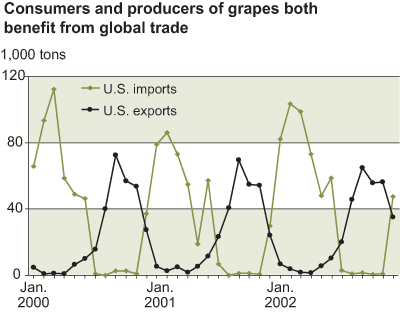Global Trade in Fruits and Vegetables Brings Variety to the Nation's Grocery Stores
- by Sophia Wu Huang
- 6/1/2004
Twenty years ago, shoppers at U.S. grocery stores contented themselves with apples, pears, oranges, and bananas. More exotic fruit was sampled mainly on cruises and as garnishes to tropical drinks. Now mangoes, papayas, avocados, kiwi fruit, and more are available on produce shelves year round. This phenomenon is due to rapid growth in world fruit and vegetable trade. Many factors lie behind this growth, especially rapid advances in fruit handling and transport technology. Regional trade agreements and changing consumer preferences have also played a strong role. A trend toward trade liberalization and an extension of trading blocs facilitated trade, while rising incomes have created a middle class that demands quality produce in all seasons and is willing to pay the price.
Improvements in transportation technology have reduced delivery time and shipping costs, so that perishable products can travel thousands of miles with no substantial loss in freshness and quality. The marketing reach of perishable products has been further extended by packaging innovations, new advances in refrigeration and atmosphere control, fruit and vegetable coatings, and other techniques that slow deterioration of food products. Satellite technologies, particularly global positioning systems, are becoming increasingly available and less expensive. These and other electronic technologies enable shippers to track their cargo around the world, monitor quality, reduce the risk (and costs) of liability claims, and shorten cargo delivery time.
Globalization of trade in fruits and vegetables has provided consumers with more fruit and vegetable varieties year-round, overcoming seasonality and smoothing price fluctuations. Fresh grapes, for example, are now available year round, as California supplies of summer and fall grapes give way to grapes from Chile, Mexico, and elsewhere during the winter and spring. Partly as a result of this trade, U.S. per capita consumption of fresh grapes increased from less than 3 pounds in the early 1970s to more than 7 pounds over the last several years. Meanwhile, the United States ships most of its grape exports—mainly to its NAFTA neighbors (Canada and Mexico) and East Asian countries—from August to November.
This article is drawn from:
- Huang, S., Calvin, L., Coyle, W.T., Dyck, J., Ito, K., Kelch, D., Lucier, G., Perez, A., Pollack, S., Pryor, S., Regmi, A., Shane, M., Shields, D., Stout, J. & Worth , T. (2004). Global Trade Patterns in Fruits and Vegetables. U.S. Department of Agriculture, Economic Research Service. WRS-0406.


